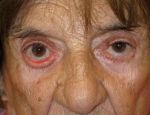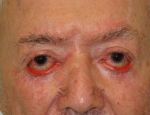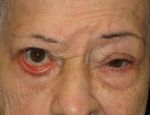Ectropion Reconstructive Surgery in Miami
A Fix for Lower Eyelid Turnout
It’s not uncommon for ectropion malposition to occur with aging or a loss of strength in lower eyelid muscles. The lower eyelid can also turn out as a result of facial palsy, an injury, or even a congenital (birth) defect. Sometimes ectropion occurs as a result of previous cosmetic surgery or scarring from other procedures. In our Miami offices, we see eyelid turns that fall into three categories:
Involutional Ectropion – Eyelid malposition due to tissues weakening (most common).
Cicatricial Ectropion – Eyelid malposition due to lack of skin or lack of elasticity in lower eyelid skin.
Paralytic Ectropion – Eyelid malposition due to nerve paralysis.
It’s important to address ectropion so the front part of the eye is properly protected from foreign objects and the tear shield can adequately lubricate the eye. Some patients also dislike the way it looks and come to us for ectropion repair surgery in Miami to bring a more youthful and healthful appearance to their eyes.
Symptoms of Ectropion
Besides the visible eyelid turnout, symptoms of ectropion can also include:
- Dry eyes
- Excessive tearing
- Redness (of the lid and the whites of the eyes)
These symptoms can be treated temporarily with prescription eye drops, but surgery is often required to completely reverse ectropion and prevent eye infections or injury to the cornea.
Ectropion vs Entropion
Ectropion and entropion are two similar eyelid conditions that refer to how the lids turn.
Ectropion – Eyelids turn out
Entropion – Eyelids turn in
The symptoms and corrective procedures for either malposition are quite alike; eye drops can also relieve entropion symptoms, as well as botox and surgery.
Methods of Ectropion Surgery
A private consultation with Dr. Tanenbaum can help determine if you’re a good candidate for corrective surgery. The goal of ectropion surgery is to correct the positioning of the lower eyelid so it properly closes and directs tears to the tear ducts.
Reasons for Ectropion Corrective Surgery
- Protect the cornea from scratching and ulcers
- Avoid scarring the inner eyelid
- Avoid eye infections
- Prevent the loss of vision
Ectropion surgery is an outpatient procedure and does require local anesthetic. Depending on the type of ectropion, surgery may involve skin grafts or AlloDerm grafts to restore function to the eyelid. If ectropion is caused by scarring, sometimes a follow-up procedure is required after the initial skin graft.
Surgery may also be performed by removing a small portion of the lower eyelid at the outer edge. Doing so allows for tightening the tendons and muscles when the remaining parts of the lower lid are stitched back together. The taut eyelid should now rest against the eye and function properly.
Post-Op Recovery
Expect to have stitches in the eyelid following surgery. Wearing a protective eyepatch is recommended for the first 24 hours post-op. Your individual care plan will be explained to you before surgery, but you will likely have antibiotic ointment to apply to the surgery site for seven days to prevent infection.
Immediately following ectropion surgery, your lower eyelid may feel tight; this will ease as you heal. Your stitches should be removed after about a week, or as deemed necessary by Dr. Tanenbaum.
Most patients experience bruising and swelling following ectropion correction surgery. A cold compress can ease these symptoms until they subside on their own. It’s recommended to avoid touching and rubbing the eyes in the week post-op.
See the Difference
Contact Us To Learn More
If you have any questions about droopy eyelids, ptosis surgery, or any other types of ophthalmic plastic surgery, please don’t hesitate to give our office a call or fill out a form to learn more. Our team is dedicated to helping you make the best decisions for your health, well-being, and self-esteem.



